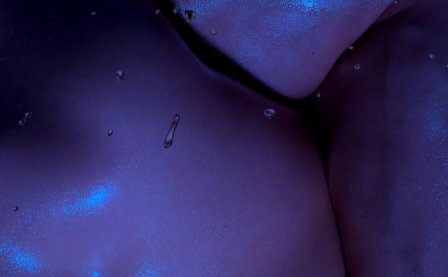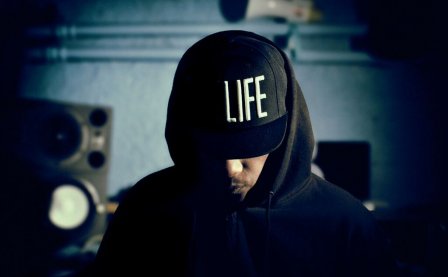For followers of what we might call the “experimental club” scene, Zora Jones and Sinjin Hawke need no introduction. Their productions — ferrous, mellifluous things — cut through the contemporary dance music landscape with precision and alacrity, enfolding the bounce of regional club musics, the grind of rap, and a classically-inflected sense of bombast to forge a sound that is unmistakably theirs. The visuals that accompany their music — hosted on their platform, Fractal Fantasy — are equally striking. In these works, the human form and the natural world are abraded by digitality, distended and striated, a hyperreal algorithmic reworking of ontology producing images of serene alienation and techno-immersion.
With the imminent release of their debut EP for Planet Mu, Vicious Circles, a trademark blend of twinkling ambience and diamond-edged club levellers, I spoke to the duo via email, a conversation that moved easily from the mechanics of collaboration to the human sensitivity to voice. Their responses speak to a deep understanding of their practice and a sense of care for the communities in which they are entangled.
Firstly, I’d like to ask about Vicious Circles. Where does the name come from? What were the circumstances that led to releasing this extended collaboration now?
ZJ: A few years ago, we started noticing a couple of “vicious circles” emerging in our lives, some internal, some external, and the spirit of this record was to actively break free of them. We essentially felt that there was a lack of inspiration in our scene that was feeding back into itself in a negative loop, and we thought that perhaps we could escape it by creating an environment for ourselves that catalyzed innovation and sonic diversity.
SH: For example, when we made this record, we tried not to work on the same song at the same time — instead, we’d put our headphones on, have two songs going on two separate laptops, and trade every 20 minutes or so. Doing that created a dynamic in which we were constantly trying to surprise each other, and this created a positive feedback loop that allowed us to experiment with ideas we wouldn’t normally slump into. As time went by, these experiments started to take on their own identity, and it became obvious that we had to release them.
More generally, what tends to be the dynamic or workflow for this kind of collaboration? Zora, in an interview with The FADER you described your process as one of being more in the moment while Sinjin’s is more a case of having an initial, overarching vision. How did those two processes work together?
ZJ: When you produce by yourself, you feed off of your own ideas in your own vacuum, whereas in collaborations you enter someone else’s space and mindset. Generally when we collaborate with others, we try to find a common ground with the artist and build from that, but the dynamic between Sinjin and I is a bit deeper. We spend most of our time together, so we know each other really well, which creates a shameless environment in which we can dare to try crazy ideas without worrying about failure.
What led you to putting this release out on Planet Mu?
SH: Planet Mu is one of our favorite labels. If you look at their back catalog, it’s hard not to be mind-blown by what they’ve achieved in terms of spreading culture and innovation.
ZJ: Artists like DJ Rashad, Young Smoke, Jlin, DJ Nate, Aphex Twin, RP Boo, and Traxman have had such a positive impact, and I love how Planet Mu curate their releases. They’re somehow able to accentuate the beauty of the songs without diluting the raw expression. So when they reached out about doing a record, it was a no-brainer for us.
Leading on from the first question, what makes for a successful collaboration, both on a personal and musical level?
SH: I feel like it’s hard to judge the success of a project simply by numbers. Some of the greatest projects never see the light of day, and some of the most abhorrent projects are commercially successful.
ZJ: I think success in creativity is a very subjective thing. In the context of collaboration, I think the connection that you share with the other artist is what makes it successful. For example, Sinjin and I went to DJ Spinn’s studio in Chicago last year; Gant-Man was there too, and we just jammed and explored a few ideas. To me, it was successful because, even if we may never release the music, it was still a memorable experience — those guys are legends, and stuff like that doesn’t happen every day. Then, of course, there’s the success of finishing a great collaboration that can just drive your adrenaline through the roof.
How do you situate yourself within the contemporary club landscape?
ZJ: It’s hard to pinpoint exactly where we’re situated, but we came up with this post-genre wave that emerged about 6 or 7 years ago. That bubble has since burst, but I like to think we’ve built our own little utopia out of the rubble.
What do you see as the logics that make it cohere, bearing in mind that the space you’re operating in, from a critic’s point of view, seems notoriously difficult to pin down, in terms of having a unified style, set of influences, etc.?
SH: It’s experimental club music at its core, because we’re quite literally experimenting with different forms of dance music primarily intended for the club environment.
ZJ: I think, musically, Fractal Fantasy forms part of the greater contemporary club landscape, although I wouldn’t say it’s defined solely by it. There are facets to the sound of Fractal Fantasy that have proximities to rap, R&B, even classical music that aren’t necessarily club-driven.
I’m interested in how Visceral Minds 2 came together. Obviously it’s much larger in scope than the first compilation and includes a wide range of collaborators. How did you know what or who to include in it?
SH: The Visceral Minds songs arose from touring and meeting up with friends around the world. We tried to include pretty much every collaboration, although some were hard to finish in time. I think all the artists on VM2 are like-minded in their approach to music but are also quite distinctive, and we really try to isolate and amplify those distinctions as much as possible within the compilation.
And then, thinking about music labels — or platforms, in your case — I’m interested in how your understanding of Fractal Fantasy has evolved since its inception, especially as you’ve started to collaborate and release more widely?
ZJ: Fractal Fantasy was never intended to be anything specific; we want it to be a fluid entity that adapts to our necessities and interests. Recently, we’ve mainly focused on music releases and accompanying interactive visuals, although we’re constantly working on different projects and collaborations, so I think the center weight will shift in the near future.
SH: Right now we’re experimenting with neural computing to generate audio and visuals, and would like to build a more substantial project with AI. We’re also working on new software, garments, instruments, installations, and we’d eventually like to build a physical space for everything to exist in.
More philosophically, your visuals — from my perspective at least — seem interested in the relationship between digital mediation and the human form, so what do you think the digital, and its visual modes, do to human form and its representation?
SH: Our brains are fine-tuned to pick up on facial expressions, body movements, posture, etc. As an artist, it’s practically impossible to make someone cry or get angry strictly with abstract imagery, but if you bring the relatability of the human form into the equation, you can start evoking all sorts of emotions. The first Visceral Minds video series was an attempt to evoke emotions strictly with abstract imagery — this was an interesting exercise, but I find it a lot more fun to play with the human figure.
Thinking about voice, Sinjin, you’ve said you’re drawn to a particular kind of choral voice. I’m wondering if you could think more broadly about voices, and whether you’re drawn to particular “voices” or “voicings” when producing?
SH: I grew up singing in an opera chorus, so you could say my musical foundation is grounded in that. Boys’ voices are very pure and fragile, which is what makes them so compelling. My voice broke when I was about 11 years old, so I can’t sing anymore, but I figured if I could recreate the timbre of a boy choralist with enough richness, I’d have an instrument that would really represent my background. I’ve been using this as my signature for the last 7-8 years and am always looking for ways to bring it to new levels.
Continuing on that theme, something like your Bodak Yellow remix seems to work so well because it hones in on what’s particular about Cardi’s voice, so that you can rework it alongside these other vocal textures and sonic layers. Is this interest in voice something that guides you in other areas, like who to remix or which “voices” to add to the platform?
SH: Humans have evolved heightened sensitivity to the frequency range between 1kHz and 10kHz in order to prioritize the human voice. For this reason, I think we have a predisposition to finding vocal-based instruments more compelling. You can stack dozens of vocal layers on a song, and it’ll still sound amazing if they’re in key with each other, which isn’t the case for many other instruments.
Is there a certain kind of voice you’re looking for when you’re seeking out collaborators?
ZJ: We both try to only work with artists who have given us goosebumps through their music… obviously we need to make exceptions here and there, but I find it works quite well.
Finally, what’s on the horizon for the two of you and for Fractal Fantasy. Can we start getting excited about Visceral Minds 3 yet?
ZJ: VM3 is currently in the works, we’re both also working on solo material, we’re about to do a small tour of our AV live set, and have a couple of installations coming up… loads of stuff really. Keep your eyes peeled!
More about: Sinjin Hawke, Zora Jones



